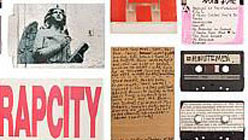When my dad died last year, my brother and I inherited everything. Not money, but things: toothbrushes and oak boxes and expired prescription bottles. Sorting through it all, I was struck by each object’s ability to conjure a scenario, and with it, a piece of my dad’s personality. A worn duffel bag with a travel agency logo on its front, filled with headphones, a book of crossword puzzles, and a pair of flip-flops, still packed from his last trip to the beach, reminded me how much he loved the ocean. Each tangible object referred to an intangible memory or quality. Rather than meaningless junk, the mundane contents of his apartment became a stand-in for all that was immaterial: his impulses, motivations, losses, and loves.
We often cling to heirlooms left behind by a past relationship or loved one, aware but unfazed by their failure to fully recapture the experience or person they represent. Our sentimental attachment and its inevitable failure is the subject of An Archive of Feelings, photographer Tammy Rae Carland’s current exhibit at the Silverman Gallery. The title refers to a seminal text on queer identity and trauma by Ann Cvetkovich. It also refers to an impossible task: the preservation and organization of emotion. Carland knows this impossibility, and so she presents us with an archive of photographed objects, a series of purposely imperfect substitutes for feelings and memories.
I thought One Love Leads to Another and My Inheritance were the strongest pieces in the exhibit. The former is a collection of mix tapes photographed against a white background. The tapes face us like artifacts in an archaeological exhibit, and we mine their labels and song lists for meaning. The collection of obsolete technology points to a bygone community of givers and receivers. Titles and playlists convey emotion and meaning. The network of cassettes also references Carland’s history in the music business as one of the co-founders of the Mr. Lady record label. But the tapes also fail. We can’t hear the music, and we can’t see the faces of the tapes’ makers. We can’t experience the long hours Carland spent with her friends listening to the tapes. Like an incomplete body of evidence, the cassettes hint at a world that has already happened, a place we can’t visit or recreate. Does anyone even still own a tape player?
Maybe I liked My Inheritance so much because it related so directly to my own experience. In it, Carland has gathered together and photographed objects left after her mother’s death. The materials suggest a life interrupted, a task started and left unfinished. We see the frayed knot of a “Born to Bingo” cross-stitch project, a box of stationery with numbers and equations written on its front. Inside, a recipe for holiday fruitcake and a receipt. An unfinished crossword puzzle and the beginnings of a quilt. The objects capture her mother’s motions, her jotted down thoughts and scribbles, her intentions and activities. More than death, the objects in the photograph reference her mother’s life. But they are also unsatisfactory. The collection feels paltry. That’s it? That’s all that’s left? The loss is amplified by the objects’ inability to represent the deceased in all her complexity and humanity.
Carland uses photography to great effect in this exhibit. The photograph is a trace, Roland Barthes famously wrote, a document of something that has already happened. It is always in the past tense. By photographing, rather than displaying, these artifacts, Carland further removes them from the present tense. She multiplies the sense of loss on display. A folded broadsheet of My Inheritance is available at the exhibit. Printed on its backside is the question, “Who will record the history of tears?” It has no answer, but the asking reflects a natural urge — to hold and quantify the intangible. That impulse underlies all the works in this exhibit.


